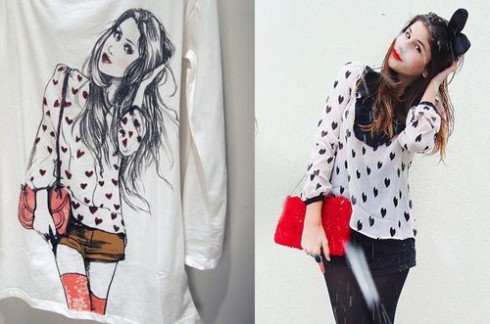Sketchy Issues: Inditex and Hermes Take Opposite Sides On Derivative Illustration Rights
Usage of photos found online is an oft debated issue: in 2007 there was the case of Flickr user Alison Chang, who found herself an unwitting model in a Virgin Mobile Australia advertising campaign; the Independent, a popular UK newspaper, ran into problems with Peter Zabulis when they failed to secure permission to feature a photo Zabulis took of snow. More recently, there’s the case of the Associated Press vs. Shepherd Fairey. Though the lawsuit was dropped in January of this year, plenty of issues remain surrounding the usage of photos in derivative works.
Now, two of fashion’s largest companies find themselves facing questions over what constitutes inspiration and what constitutes copyright violation.
Trending Topics, a blog from Spanish newspaper El Pais, reports (in Spanish) that Spanish retailing giant Inditex has once again used illustrations of fashion bloggers for a line of t-shirts without prior permission from the bloggers.
In May 2010, Betty Autier of Le Blog de Betty noticed a t-shirt in Zara that featured an illustration bearing a striking resemblance to one of her photos. The only problem? Autier was never contacted by the illustrator or Zara about usage of the image.
Michèle Krüsi is a 19-year-old blogger from Switzerland who, like many other bloggers, posts personal style photos to Lookbook.nu. Lookbook.nu serves as inspiration for plenty of personal style fans, including those at some of fashion’s largest brands. Someone from Stradivarius, a Spanish retailer also owned by Zara’s parent company Inditex, took inspiration from this image of Krüsi and created a t-shirt based on it.
“If they had asked me there would be no problem, and of course I would have told them they could use the photo if I had been offered one of the shirts or something,” Krüsi says. {Trending Topics/El Pais}
Louise Ebel, who is known to readers as Miss Pandora, also found herself an unwitting subject of Stradivarius’ new line via an illustrated appearance on two different shirts.
Ebel says “I’m really disappointed to find my work, and the photographers with whom I made the photo shoots, on T-shirts, and without having been warned. I think it’s disrespectful and it detracts from our work. I have been used and undervalued.” This actually marks the 3rd time Ebel has been illustrated for a t-shirt by an Inditex brand. The first time was in the same collection with the image of Betty Autier that sparked the debate. {Miss Pandora}
The legal issues here are a bit fuzzy though: while using the photo as is for a commercial purpose would be an obvious violation of the photographer’s rights, do those same rights extend to a derivative work? Those were the issues Fairey and the AP were to argue before settling their case, but with the settlement they still remain. In the US there is a pending fashion copyright bill, but even if it should become law, the issue of what’s protected and what’s fair use in derivative design isn’t totally clear.
As far as any moral questions, the fact is that fashion brands don’t even agree on the basic issues as an industry.
The Hermes Birkin bag is a coveted style status symbol, and fairly recognizable. Independent fashion label Thursday Friday decided to print an illustration of a Birkin bag on a canvas shopping tote. {She Finds via Styleite} Something of a wink and nod to the classic bag that normally retails for thousands of dollars. The Thursday Friday website says:
“We realized we were using the shopping bags as proxy accessories and wanted to take them a step further, to have the bag itself declare what’s going on. So we ended up with a surreal design that references luxury but ultimately works as an anti-status status symbol.”
Except Hermes found nothing surreal about the design, and is suing the company for “riding on their reputation” and “confusing, misleading, and deceiving the public.” Seemingly placing Hermes on the same side of the table as those who were angered over Zara’s usage of blogger photos for illustration inspiration without notice.
Ganymede Kids posted an interesting analysis of the first Zara situation, which is worth reading regardless of which side of the issue you find yourself on; and this TED talk from Johanna Blakley raises interesting points as well.
When bloggers and decades old brands, who’ve never looked upon imitation with any feelings of flattery, end up on the same side of an issue it’s a sure sign that new media mavens aren’t the outsiders the old guard likes to believe they are. Welcome to the inside.

